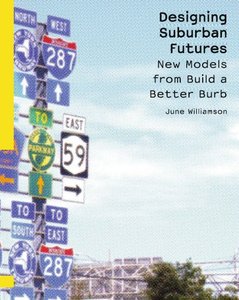Suburban sprawl has defined much of the last half century of North American development. Suburban design and use have changed continuously throughout this period and are still evolving as suburban retrofit projects become ever more common.
Suburban sprawl has defined much of the last half century of North American development. Suburban design and use have changed continuously throughout this period and are still evolving as suburban retrofit projects become ever more common. Although the suburban form is central to how North Americans live and cities develop, they are nonetheless often “excluded from the urban imagination and discourse surrounding cities, sustainability and urban resilience.” Much of the research surrounding suburbia focuses on problems, the emerging challenges and their respective roots. In Designing Suburban Futures: New Models from Build a Better Burb, June Williamson takes on the heady challenge of how to solve these problems in an economical, environmental, social and ecological manner while recognizing the ever-looming obstacles of regulatory standards and “financing practices that have reproduced suburbia for the past 60 years.”
Williamson presents this book as a call to action on the myriad issues associated with the “dominant types of sprawling suburban form”. While concentrating on the enormous task ahead, the book is written through a lens of hope – seeing the vast potential for urban resiliency and the potential global impact of successful suburban retrofit strategies. An optimistic air pervades the entire book, which is presented extremely well with a plethora of pictures, renderings and graphs. Williamson’s clear, concise structure and writing make for an enjoyable and informative read. Although the subject matter often errs towards breadth rather than depth, the author provides a thorough enough overview that the reader can grasp the subject at hand and is given plenty of references if they wish to pursue further readings.
Designing Suburban Futures is essentially two separate entities. The first details the history of suburban sprawl from the 1960s to present and how design has responded accordingly. It continues by delving into the strategies for a better suburban future. This section is reminiscent of Williamson’s previous book, Retrofitting Suburbia (co-authored by Ellen Dunham-Jones), building upon the award-winning predecessor by providing a diverse range of strategies focusing on building type, landscape, transportation and energy. Many of these strategies could easily be coupled or adapted to work in sync. The latter half of the book concentrates on the Build a Better Burb competition, which asked entrants to develop retrofitting scenarios for downtown Long Island, and seven noteworthy competition submissions.
Designing Suburban Futures is an excellent resource for students in a variety of disciplines related to the development or redevelopment of suburbia and to the general public as it provides a clear, understandable overview of the evolution of the suburbs and concrete, accessible examples of how improvements can be made. The book’s interdisciplinary nature makes it a useful educational resource for planners, architects, landscape architects, developers and politicians.
Rooted in strong academic research, the practicality of this book gives it immense potential to impact development and redevelopment discussions and practices in Canada and across the globe. By presenting a variety of strategies which emphasize different components of the retrofit process (environmental, economical, social, ecological) this book offers different perspectives and will hopefully open discussion lines for differing parties to find common approaches.
Designing Urban Futures: New Models from Build a Better Burb, June Williamson, Washington: Island Press, 2013, 137 pages
Reviewer Information
Maxwell Hartt is a PhD student in the school of planning at the University of Waterloo where his research focuses on shrinking cities, their challenges and the corresponding urban planning response.













